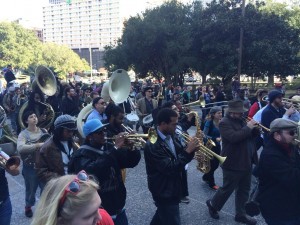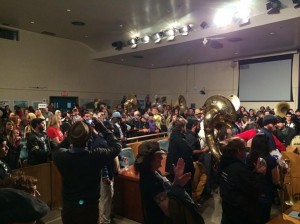Text by DJ Ruby (DooBeeDoo’s New Orleans contributor)
In New Orleans the debate surrounding changes to the city’s noise ordinance continues to divide the city. The polemics surrounding the most recent set of changes to the city’s laws regarding sound began in December of 2013 when the New Orleans city council proposed restricting the decibel levels permissible in public space to their 1997 levels. The debate has made clear that the roots of this struggle run deep and has raised interesting questions about culture and preservation in the City That Care Forgot.
For bystanders the morning of January 17th might have appeared to be something of a celebration, but for those who participated, the demonstration at City Hall was an expression of complicated and layered feelings around the newest proposed sound ordinance. The collective voice of local musicians and their supporters echoed in the face of what has felt like a continuous effort to quiet them down, nevertheless progress on negotiations was stalled. On that morning City Hall was meant to accommodate a public hearing regarding the proposed changes to the noise ordinance that had undergone increasing scrutiny since its proposal in December. Musicians, residents and lawmakers were poised to present their cases in the chambers after months of discussion. But on the evening of the 16th the hearing was abruptly cancelled. The further postponement of a debate that has been affecting the cultural community for some time now felt like another rebuff and many felt that postponement was a tactic to lessen the traction gained by the musical community in the months leading up to the hearing.
In a statement justifying the 11th hour cancellation, Council members Kristin Gisleson Palmer and Stacy Head cited “much public consternation…and fear that the hard work of the many constituency groups…was not followed”. In response, a large group of New Orleans musicians headed up by trombone player Glen David Andrews filed into the city council chambers on the morning of the 17th. The room was filled with music and protest, and speakers voiced concerns about the ordinance in what turned into an impromptu forum (http://www.bestofneworleans.com/blogofneworleans/archives/2014/01/16/sound-ordinance-withdrawn-at-11th-hour-city-council-hearing-scheduled-for-friday-cancelled).
Following the demonstration and ardent opposition from musicians, club owners and residents, the council withdrew the ordinance in February with a promise to submit a new revised draft in the coming months. Despite the council’s initial retreat the sound debate rages on. Amid a flurry of threats, conflicting opinions and protests this debate has divided residents on how to maintain the city’s role as the epicenter of preservation and production of one of America’s most unique living indigenous art forms while keeping residents satisfied about the expected quality of life in one of the city’s priciest real estate markets.
This struggle over noise is a particular offshoot of a wider discussion concerning New Orleans’ ever-changing demographic landscape which tourists, long-time residents, musicians and culture bearers, club owners, transplants from other cities, lawmakers co-create. The tension that results from the intersecting conflictual interests of these parties is of a particular flavor in New Orleans where oftentimes such the debates center around what some would call lifestyle, what others would call vice. This tension never resolves, it only evolves and with it changes the character of the city.
Consider the early 1900’s in New Orleans. The legendary red light district known as Storyville, home to Louis Armstrong and Jelly Roll Morton and many a brothel was a Mecca for anyone with a taste for exposure to the extraordinarily lascivious. Storyville enjoyed the most notoriety from 1897 to 1917 when it was considered both the scandal and the glowing gem of the city. Visitors flocked to take part in the raucous debauched glamour of the music and gambling halls and engage the services of women perched on stoops of brothels that were not illegal in this portion of the city. It was in the dark lit clubs of Storyville that Black and Creole musicians could be found blowing horns into the wee hours of the morning and playing the hot sounds that we now consider jazz music. For many New Orleanians, though, (mostly upper and middle class New Orleanians to be precise) this “prostitution district” was an eyesore and a nuisance. From their perspective Storyville fomented vice and attracted all manner of “undesirable ruffians” to the city. Prominent social reformers who opposed prostitution joined with civic groups and began working to shut down the district with help from President Wilson and the U.S. Navy who were worried for the health of its sundry sailors. By 1917 their efforts were successful and Storyville was a legend of the past.
Though the Storyville situation is different in a number of crucial ways from the current debate, there are a few obvious parallels that lend some perspective to the modern discord. In both cases there is an obvious tension between those who tie quality of life to peace and quiet and to this end are lobbying for a healthy place to lead their lives, those who make a living producing art in what the former consider unhealthy or undesirable living environments and those who recognize the selling power of these unhealthy zones to non-residents. In a city that has historically been both valued and exoticized for its lackadaisical approach to that which is heavily regulated in other U.S. cities (see drinking, music, sex work, cost of living) the debate about what to preserve and how to preserve it is ever-present.
Recently, in 2010 the issue made headlines when The To Be Continued (TBC) Brass Band, a group that could be found playing on the corner of Bourbon and Canal Streets, was issued a warning by police late one night saying that the city was going to begin enforcing the existing ordinance concerning decibel levels. Though they had been playing there and attracting large admiring crowds for years, the group was informed that they were exceeding permissible decibel levels with their unamplified brass music. TBC is widely recognized among locals and knowledgeable observers alike (see The Roots http://
This crackdown took place as the new police chief Ronald Serpas felt compelled to respond to French Quarter residents’ continued complaints about noise and lack of enforcement of existing ordinances. The musical community was vocal in their opposition to this seemingly arbitrary series of raids and the police, alarmed, responded with something of a moratorium on enforcement of the existing code. Notably, club owners along Bourbon were not approached with requests to turn their speakers away from their windows or to turn down the volume of their sound systems.
Brass bands, however, playing nightly in the open air were easy targets for police looking to appease wealthy residents of the Quarter. Live music on a street corner is an emblematic manifestation of New Orleans musical culture. And any visitor to New Orleans will admit that street music is a significant draw for the 9 million people and their accompanying $6 billion dollars who turn up every year looking for the authentic New Orleans experience hoping to find it on the corner of Frenchman and Esplanade.
New Orleans Mayor Mitch Landrieu was recently proud to report the high tourism numbers from 2013 that keep the city’s economy afloat. (http://theadvocate.com/news/
“Music is not a crime” has become the rallying cry for opponents to the current ordinance that include local songstress Meschiya Lake who has called the ordinance “unrealistic”. Chicago born trumpeter Mario Abney acknowledged that New Orleans is special in its regard for the cultural arts, “This isn’t Nashville. This isn’t Austin,” he said. “This isn’t Chicago. I moved here so I could play my horn,” he said at the City Hall protest in January. Opponents say this new ordinance and attempts at enforcing prior ones have amounted to the criminalization of sound production. Speaking to these sentiments, former city council president Jackie Clarkson said of the scope of the ordinance “We want to kill noise … and save hearing and music, especially live music.”
In the fall of 2011, Council member Kristin Gisleson Palmer engaged the services of David Woolworth of Mississippi based Oxford Acoustics to conduct a study of sound levels in New Orleans and to work with various interest groups to propose changes in the City’s laws. Palmer was charged with revamping the city ordinance in the wake of the 2010 crackdown and subsequent opposition. Their collaboration resulted in a comprehensive report, which was released to the public in August 2013 and contained recommendations that were used to inform the first draft of the ordinance. Woolworth’s recommendations went completely unheeded in the first draft of the ordinance. His contract has now been renewed through the end of 2014 to help with the ongoing drafting process. Woolworth’s work raised a number of interesting questions about how to measure and regulate sound. For instance, how does a venue regulate human noise emanating from large crowds? And how close to a venue is an appropriate place to take a decibel reading? (http://maccno.com/?p=214)
Though the ordinance applies to how sound would be measured across the city, much of the debate has swirled around Bourbon Street and nearby Frenchman Street, which houses some of the most outspoken supporters and critics. The points detailed in City Council’s revision of the existing ordinance are based largely on a seven-point platform proposed by the VIEUX CARRE PROPERTY OWNERS, RESIDENTS & ASSOCIATES, INC. (VCPORA), a coalition of 13 neighborhood associations. Specific to the French Quarter, VCPORA called on the city to return to 1989 decibel requirements, which would set a 60db limit in residential areas from 10 p.m. – 7 a.m., as well as a 65 db limit in commercial areas. Residential areas of the French Quarter would be subject to an 85 db maximum. It is likely that the next draft ordinance will focus entirely on Bourbon Street and the surrounding residential areas.
Undoubtedly the cacophonous entertainment strip in the city, Bourbon Street is a bustling passage lit by the neon glow of karaoke bars and swirling Daiquiri machines that was once home to serious jazz establishments instead of gimmicky music halls that draw tourists by the droves. By the mid-1980’s the comparatively quieter jazz clubs with their unamplified horn sections were supplanted by music clubs hosting cover bands that performed a rotating hit parade to appease visitors looking for the Bourbon St party. It is a loud place, and its only getting louder given the technological advancements in sound amplification in recent decades. Robert Watters, French Quarter Management District Chairman and owner of Rick’s Cabaret, a club on Bourbon Street are outspoken about their opposition of the ordinance despite their acknowledgement of the loudness of his speaker system. He feels that the ordinance is aimed at shutting down loud clubs like Rick’s.
Despite Watters’ concern, it isn’t the large clubs that are bearing the brunt of the noise enforcement. Rather it is the low hanging fruit like street performers and small neighborhood clubs that are getting picked off in the noise squabbles.
Mimi’s in the Marigny is a cozy bar in a neighborhood adjacent to the French Quarter that regularly hosted live music from local alto-saxophonist Aurora Nealand and local tastemaker extraordinaire DJ Soul Sister. In April of 2012 their license for live music was revoked following complaints from neighbors that the music emanating from the open doors and windows was too loud (http://www.noladefender.com/
Following that rash of local trumpeter and frequent Treme guest Kermit Ruffins led opposition along with the Music and Culture Coalition of New Orleans (MACCNO) to consolidate musicians’ and entertainers’ opposition into an audible voice. MACCNO formed in the wake of these incidents to serve as a mouthpiece for the cultural economy of the city. Representing the interests of musicians, street performers, venue owners, traditional culture bearers like Mardi Gras Indians, MACCNO said in a statement that this most recent ordinance would make it “much easier to shut down venues that offer any form of live entertainment.” Representatives from MACCNO feel that the changes have been pushed forth with limited input from the cultural community. They said in a statement to the Times Picayune “The backroom dealers aren’t interested in finding solutions that support livable neighborhoods while also supporting the economy, creating jobs, or encouraging growth. Instead, they are interested in using their money and influence to get exactly what they want.” According to MACCNO the city would do well to break the drafting committee into thirds to give the varied groups adequate representation. They propose one third citywide residents, one third musicians and culture bearers and one third business and tourism representatives. In the wake of the cancelled January 17th hearing MACCNO said in a statement “Were winning, but its not over. It’s not over…until a new process has been announced”.
At the crux of this ongoing conflict is the way New Orleans lawmakers and residents imply through legislation that musicians and culture-bearers like Mardi Gras Indians or Social Aid and Pleasure Club members (http://www.neworleansonline.
Without question these groups should play a central participatory role in the planning and drafting of any city ordinance regarding noise, the joyful making of which is part and parcel of their daily lives and the daily rhythm of the city.
Though a new draft ordinance was slated for introduction at a March 27th meeting, there has been no movement in this regard so far. As discussion around a new ordinance continues, the city would do well to reach out in earnest to the musicians, Mardi Gras Indians, and second liners for their expertise in how our culture can be best preserved in the face of an ever changing New Orleans landscape. Neighborhood groups appealing directly to municipal government without input from the affected musical community should consider more closely how this lack of input will work to the detriment of a healthier more livable city for all its residents, and instead create ever growing maelstrom of discontent and distrust.
Update:
The Bourbon St. Sound Ordinance was read the day before yesterday on April 11th at the New Orleans City Council Meeting. There is likely to be time for public comment on this draft at the Housing and Human Needs Committee meeting on April 21st. The council is likely to vote on the new ordinance on April 24th.
Recommended Article
Debate on Bourbon St.: Should the Good Times Roll Less Loudly? By CAMPBELL ROBERTSON,





